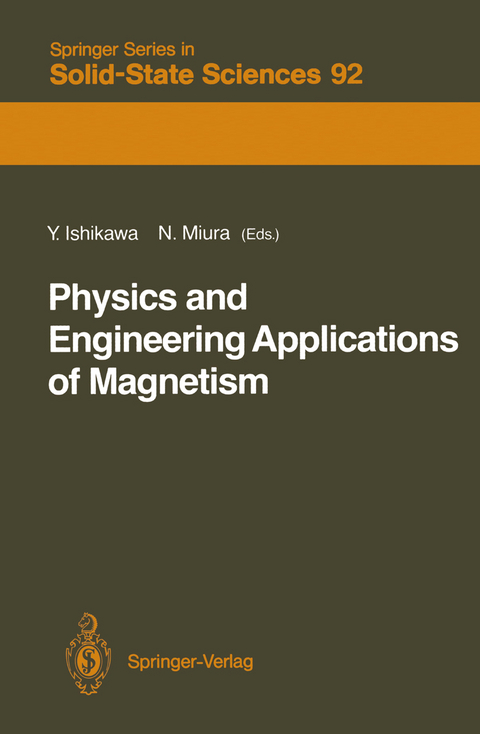
Physics and Engineering Applications of Magnetism
Springer Berlin (Verlag)
978-3-642-84160-6 (ISBN)
Physics and Engineering Applications of Magnetism deals with one of the most important and fundamental research subjects in solid-state physics. For the first time a unified treatment of both the basic physics and the technological applications of magnetism is given. Among the topics discussed are: the generation and application of ultra-high magnetic fields; compound, amorphous, and thin-film magnetic materials; magneto-optic recording; and the imaging of magnetic domains.
1. Progress in the Physics of Magnetism in the Past Forty-five Years.- 1.1 Magnetism of 3d Transition Metals and Alloys.- 1.2 Magnetism of Rare Earth Metals and Alloys.- 1.3 Magnetism of Ferrimagnetic Oxides.- 1.4 Observation of Ferromagnetic Domains.- 1.5 Experimental Techniques and Environments.- 1.6 Engineering Applications of Magnetic Materials.- 1.7 Conclusions.- References.- 2. Generation of Megagauss Magnetic Fields and Their Application to Solid State Physics.- 2.1 Various Techniques for Generating Ultra-high Magnetic Fields.- 2.2 Electromagnetic Flux-Compression.- 2.3 Single-Turn Coil Technique.- 2.4 Magnetism Experiments in Megagauss Fields.- References.- 3. Magnetism in Metals and Alloys Studied by Neutron Scattering.- 3.1 Significance of Neutron Scattering for the Study of Magnetism.- 3.2 Studies of Antiferromagnetic Metals with Elastic Scattering.- 3.3 Ferromagnetic Metals Studied by Inelastic Scattering.- 3.4 Spin Dynamics in Localized Spin Systems.- 3.5 Spin Dynamics in Itinerant Electron Systems.- 3.6 Spin Dynamics in Quasi-Localized Spin Systems.- 3.7 Dynamic Behavior of Invar Alloys.- 3.8 Epilogue - The Magnetism of Fe and Ni.- Addendum.- References.- 4. Magnetic Properties of 3d Compounds with Special Reference to Pyrite Type Compounds.- 4.1 General Survey of 3d Magnetic Compounds.- 4.2 Experimental Results.- 4.3 Theoretical Interpretation.- References.- 5. Invar Systems.- 5.1 Magnetovolume Effects.- 5.2 Invar Type Alloys.- 5.3 Elasticity.- 5.4 Conclusions.- References.- 6. Magnetic Anisotropy and Magnetostriction.- 6.1 Magnetocrystalline Anisotropy.- 6.2 Magnetostriction.- 6.3 Representative Materials and Topics.- 6.4 Realization of High Magnetic Permeability. "The Focus of Zero" in Magnetic Anisotropy and Magnetostriction.- 6.5 InducedMagnetic Anisotropy. How to Control the Shape of Magnetization Curves.- References.- 7. The Intermediate Field Between Pure and Applied Magnetism. Importance of Accurate Measurements of Magnetization Curves.- 7.1 Technical Terms and Figures.- 7.2 Estimation of Saturation Magnetization and Curie Temperatures.- 7.3 Magnetic Anisotropy.- 7.4 Magnetostriction and Magneto-elastic Energy.- 7.5 Spin Glasses, Hopkinson Effect and the Invar Problem.- 7.6 The Problem of Communication Between Applied Researchers and Those in the "Intermediate Fields" or in Basic Research.- 7.7 Conclusion.- References.- 8. Amorphous Magnetic Materials.- 8.1 Magnetization and Temperature Dependence of Amorphous Magnetic Materials.- 8.2 Magnetic Anisotropy.- 8.3 Magnetism, Preparation Conditions and Structural Relaxation of Amorphous Alloys.- References.- 9. Amorphous Magnetic Alloy Ribbons and Their Applications.- 9.1 Materials.- 9.2 Applications.- References.- 10. Magneto-optical Recording.- 10.1 Principles of Recording, Reproducing and Erasing.- 10.2 Requirements for Recording Media.- 10.3 Recording Media.- 10.4 Dynamic Read Write Properties.- 10.5 Applications and Other Technologies.- References.- 11. Magnetic Bubble Memories. Solid State File Utilizing Micro Magnetic Domains.- 11.1 Physics of Magnetic Bubbles.- 11.2 Magnetic Bubble Materials.- 11.3 Magnetic Bubble Devices.- 11.4 Magnetic Bubble Memories and Applications.- 11.5 Future Trends of Magnetic Bubble Devices and Memories.- 11.6 Summary.- References.- 12. High Density Magnetic Recording. Recent Developments in Magnetic Tapes, Discs and Heads.- 12.1 Physics of Magnetic Recording.- 12.2 Magnetic Tapes and Discs.- 12.3 Magnetic Heads.- 12.4 Future Trends.- References.- 13. Magnetic Domains Observed by Electron Holography.- 13.1Principles of Electron Holography.- 13.2 Principles of Domain Structure Observation.- 13.3 Applications of Magnetic Domain Structure Observation.- 13.4 Summary.- References.- Appendix: Notes on Technical Terms.
| Erscheint lt. Verlag | 12.2.2012 |
|---|---|
| Reihe/Serie | Springer Series in Solid-State Sciences |
| Co-Autor | K. Adachi, S. Chikazumi, E. Hirota, N. Imamura, Y. Ishikawa, Y. Makino, N. Miura, T. Mizoguchi, Y. Nakamura, Y. Sugita, K. Tajima, M. Takahashi, A. Tonomura, T. Wakiyama |
| Zusatzinfo | XIII, 317 p. |
| Verlagsort | Berlin |
| Sprache | englisch |
| Maße | 155 x 235 mm |
| Gewicht | 516 g |
| Themenwelt | Naturwissenschaften ► Physik / Astronomie ► Atom- / Kern- / Molekularphysik |
| Naturwissenschaften ► Physik / Astronomie ► Elektrodynamik | |
| Technik ► Elektrotechnik / Energietechnik | |
| Schlagworte | Magnetic Devices • Magnetic field • magnetic material • magnetic materials • magnetism • Material • Physics |
| ISBN-10 | 3-642-84160-0 / 3642841600 |
| ISBN-13 | 978-3-642-84160-6 / 9783642841606 |
| Zustand | Neuware |
| Haben Sie eine Frage zum Produkt? |
aus dem Bereich


